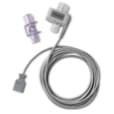Maybe the single most important reading that can be taken from a patient to truly measure their current physiological state is their expired CO2 measurement. This parameter plays an even more prevalent role in the administration of anesthesia. There are two ways to measure CO2 in clinical applications,  mainstream or sidestream. In this article, we will provide a brief overview of each method. For CO2 monitoring, or Capnography, the method is either “diverting” or “non-diverting”. Diverting, or taking the sample gas from the airway and transporting it through a tube to the sensor, is the way in which sidestream CO2 monitoring works. Non-Diverting, or having the sensor at the sample site (airway), is the way in which mainstream CO2 is performed. The measurement is achieved when the sample air passes through an infrared light, which when equipped with the proper detector can provide a measurement for the CO2 .
mainstream or sidestream. In this article, we will provide a brief overview of each method. For CO2 monitoring, or Capnography, the method is either “diverting” or “non-diverting”. Diverting, or taking the sample gas from the airway and transporting it through a tube to the sensor, is the way in which sidestream CO2 monitoring works. Non-Diverting, or having the sensor at the sample site (airway), is the way in which mainstream CO2 is performed. The measurement is achieved when the sample air passes through an infrared light, which when equipped with the proper detector can provide a measurement for the CO2 .
Mainstream CO2
Mainstream CO2 is measured through the use of a sensor that is inserted via an airway adapter. The sample is taken directly from the airway. This method provides a very accurate reading because since the sensor is at the actual airway, there are far less variable involved that could interfere with an accurate  reading (see sidestream summary below). The sensor is corded and connects to the patient monitor and the sensor located at the distal end snaps into an adapter in the airway tubing, mask, etc. The greatest concern with this sensor is that it is susceptible to damage from mishandling, dropping it on the floor, etc.
reading (see sidestream summary below). The sensor is corded and connects to the patient monitor and the sensor located at the distal end snaps into an adapter in the airway tubing, mask, etc. The greatest concern with this sensor is that it is susceptible to damage from mishandling, dropping it on the floor, etc.
Sidestream CO2
Sidestream CO2 uses a sensor that is located inside the monitor instead of an external sensor. For this method, the patient’s exhalation air is pulled through a small tube, usually 6-8’ long, from the sample site (usually a nasal cannula or a mask) and into the monitor. Usually the sample tube first will enter a water trap and/or filter which is attached to the monitor. The water trap is used to trap the heavier water vapor from entering the monitor, which can cause damage and errant readings.

Conclusion
Mainstream is widely regarded as the more accurate method of measuring CO2 readings. The disadvantage is the sensor, which is prone to being dropped or damaged and is quite expensive to replace. Industry advancements have made the sensor less vulnerable to damage, but the risk still exists.
Sidestream CO2 probably has less potential for major parts replacement because the sensor is internal. The readings may be less accurate because of the variables involved with pulling the sample from the patient to the monitor, then through a water trap, and into the internal sensor. Also, when using anesthetic agents, sidestream monitoring needs to have a scavenge system in place to divert the expired and sampled gas safely back into the anesthesia machine so that the room air during the procedure gets contaminated with expired anesthetic agent.
Both methods are acceptable for measuring CO2. Further research may indicate which method is more advantageous to utilize for your specific procedures and situations. The most important aspect may not be about whether the method is sidestream or mainstream, but that you are monitoring CO2.
